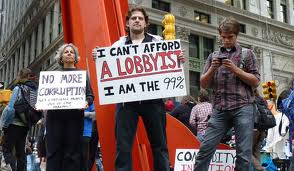At one point, I watched as a news crew interviewed Michael. They wanted to hear about the anger we all felt, but Michael insisted there was no anger, and surprisingly, I think he was right. Sure, people are unhappy, but it didn’t feel that way down there. It felt optimistic, hopeful, and even joyous. One fifty year old woman I spoke to, a professional who had lost everything when the housing bubble crashed, said that these days she felt safer and happier at the protest than any elsewhere. Michael said he saw very little anger, but that wasn’t what the news company wanted to hear. The reporter spoke to her boss and she was told to cancel the interview. No one wanted to see something about hopeful, positive protesters. They wanted anger and arrests, pepper-spray and dirty hippies. As the news shows, if you look for something, you’ll find it, and I’m sure this reporter did too.
I did see one bit of anger, but it wasn’t from the protesters, but from a ‘tourist’. A angry man in a suit ended up shouting at the man with the detailed banking proposal on his poster-board sign. “Where were you when the Tea Party was marching?” he asked, disgusted. I was proud that the protesters stayed rather civil with him, although he was far more aggressive in his accusations. Still, he did have a point. How was this different?
I saw the above exchange in the first hour I was there, but that moment stuck with me longer than the rest. The guy had a point. I thought back to when I first heard about the Tea Party, and I remember being briefly sympathetic. But it wasn’t long before I scorned them right along with the rest of my liberal friends. I tried to remember what changed, and social issues were the most obvious thing that caused me to write them off as misguided. However, other than the stances on social issues (in which OWS comes clearly down in favor of progressive policies), the two movements have a lot in common. Both clearly stem from a recognition that government by the people for the people is falling apart and that the system has failed too many. Both were initially popular movements made of regular people. The Tea Party these days seems to have been mostly subsumed into the Republican establishment, with strong corporate backing, but OWS is still young and may soon find itself in a similar situation.
I did see one important difference between OWS and the Tea Party – philosophy of government. The Tea Party views government as an inherent problem; big government is inherently inefficient and wasteful, and private enterprise is efficient and effective. Government is the problem, not the solution. OWS seems to agree that government is broken, but it believes that corporate culture did the breaking. From that point of view, government by the people is a good thing, but impossible in our current climate. Government isn’t inherently the problem, but is because it’s bought and paid for. Fix the corporate climate, and government becomes a force for good.
I see both sides of this issue. I agree that government bureaucracy is wasteful and inefficient, but I believe that this is a matter of scale – look at the sheer waste of government dollars paid to private companies in Iraq and Afghanistan. However, I (and most of the people at OWS I believe) would rather have a wasteful government healthcare (just one example) than corporate healthcare and insurance. Why? Because the government program’s purpose is to take care of it’s citizen’s health. That’s the bottom line. The insurance companies bottom line is on their financial sheet. They are responsible to shareholders, not their clients and it is in their best interest to NOT pay for medical care. Beyond that, I’d rather have billions of dollars wasted on doctors and medicine than billions in dollars in profit for executives who try to cut costs and deny coverage whenever possible. Honestly, when it comes to health, I view ridiculous insurance profits as more inexcusable than government waste. But that’s just my own pet issue.
I’ve heard many people who support the Tea Party exclaiming that OWS is anti-American and anti-capitalist. No doubt that there are many who could be called anti-capitalist in the movement (or communist, socialist, or anarchist), but I’m not sure it’s as broad as the news would have you believe. Many people think they’re anti-capitalist, but are actually anti-something else, as they don’t have much of an understanding of capitalism. I spoke to one man in his 60s, a salesman, who put it beautifully: “I’m a capitalist,” he said with a note of pride, “I’ve never had a cushy salary job, or paid vacation, or anything, and I’ve worked 33 years in this job.” What was he against? “Greed,” he said simply, adding that capitalism is all about making a good product and selling it honestly. He complained that instead these companies cheat, steal and lie, and then buy political power to protect themselves and insure monopolies.
There is a difference between capitalism and plutocracy. The later encourages monopolies of a few rich individuals and companies. The number of major banks in this country keeps shrinking as the biggest banks gobble them up. Competition against them is impossible, just like it is among the telecoms, and big outlets like Walmart that routinely destroy small businesses and turn small towns into their personal fiefs. Monopolies and plutocracies are anti-competition, and therefore anti-capitalist. And of course, that makes them as un-American as can be.
But it was social issues that really turned me off the Tea Party: hostility to gay marriage, racism, and religious extremism of the Christian variety. But seeing news coverage of OWS and comparing to the reality I saw with my own eyes, I have to wonder if I was misled. I have no doubt that much of what scares me about the far right is present in the Tea Party, but I have to wonder if that’s just where the cameras were pointed, much like the young anarchist punks down at Liberty Park seem to get most of the attention from the media. Clearly, OWS and the Tea Party have very different social values, but both are crying out for fairness, transparency, and accountability. They identify different sources of the problem, and different solutions. I still think the Tea Party’s anti-government philosophy and faith in an unregulated market is misguided, but OWS has plenty of its own problems. But they have more in common – both are popular movements, drawing regular people who don’t actually know much about politics or policy, but see that this country is being taken for a ride. I don’t think the Tea Partiers see things clearly, but neither do most people down at OWS. When there’s so much emotion, how can anyone think clearly? Then again, no one elected them – it’s not their job nor responsibility to write laws. Many have few resources (or none thanks to the job market), and few have much access to the political process beyond choosing the lesser of two evils and pulling a lever every couple of years. But they know that something has to be done, and like me, they want to help make this country better. In the final analysis, both the Tea Party and OWS are made up of patriots who disagree, but are patriots nonetheless.
Protest actions and passive resistance don’t create laws, politicians do, but politicians feel social pressure acutely. Social pressure works. Egypt proved that, Martin Luther King Jr. proved that… hell, the Tea Party proved that, helping to steer the political dialogue of the 2010 elections in their favor. OWS is not an organization, not really. It’s not a political party. It’s a symbol, and a powerful one at that, and people are responding. As the night fell Friday night, I departed, tired, bewildered, yet energized. Like others I talked to, I found the protest frustrating, inspiring, maddening, and uplifting, all at once. Like any symbol, it means something slightly different to everyone who experiences it, but that is its power, its strength. So bewildered was I that I had trouble finding the subway, despite having worked two blocks away from the park for over a year. On the crowded subway, in the press of tired bodies heading home, I felt a strange sense of unity with the people on the train, even if they didn’t know it. I looked around and realized that everyone I saw was part of the 99%.






